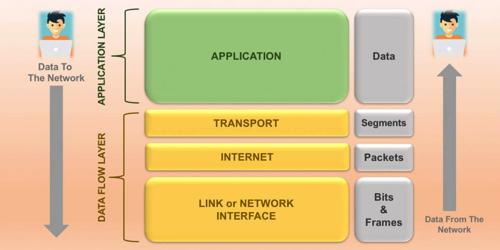Transmission Control Protocol or Internet Protocol (TCP/IP) is a suite of communication protocols used to interconnect network devices on the internet. Like the OSI network model; TCP/IP also has a network model. TCP/IP was on the path of development when the OSI standard was published and there was an interaction between the designers of OSI and TCP/IP standards. The TCP/IP model is not the same as the OSI model. OSI is a seven-layered standard, but TCP/IP is a four-layered standard. The OSI model has been very influential in the growth and development of the TCP/IP standard, and that is why much OSI terminology is applied to TCP/IP.
Layer 1. Network Access Layer: Network Access Layer is the first layer of the four-layer TCP/IP model. Network Access Layer defines details of how data is physically sent through the network, including how bits are electrically or optically signaled by hardware devices that interface directly with a network medium, such as coaxial cable, optical fiber, or twisted pair copper wire.
The protocols included in Network Access Layer are Ethernet, Token Ring, FDDI, X25, Frame Relay etc.
Layer 2. Internet Layer: Internet Layer is the second layer of the four-layer TCP/IP model. The position of Internet layer is between the Network Access Layer and Transport layer. Internet layer pack data into data packets known as IP datagrams, which contain source and destination address (logical address or IP address) information that is used to .forward the datagrams between hosts and across networks. The Internet layer is also responsible for the routing of IP datagrams.

Fig: Layers of Transmission Control Protocol
Layer 3. Transport Layer: Transport Layer is the third layer of the four-layer TCP/IP model. The position of the Transport layer is between the Application layer and the Internet layer. The purpose of the Transport layer is to permit devices on the source and destination hosts to carry on a conversation. Transport layer defines the level of service and status of the connection used when transporting data.
The main protocols included at Transport layer ore TCP (Transmission Control Protocol) and UDP (User Datagram Protocol).
Laver 4. Application Layer: Application layer is the topmost layer of the four-layer TCP/IP model. The application layer is present on the top of the Transport layer. Application layer defines TCP/IP application protocols and how host programs interface with Transport layer services to use the network














